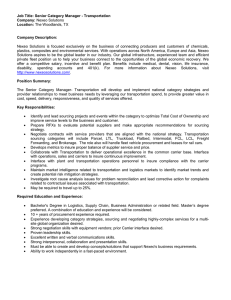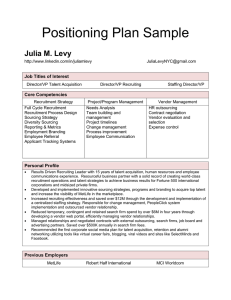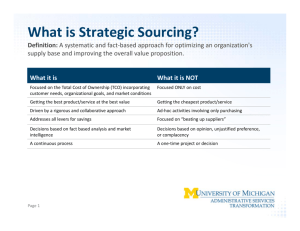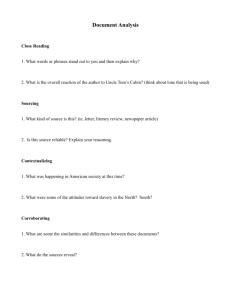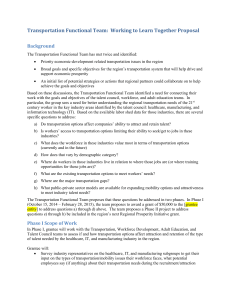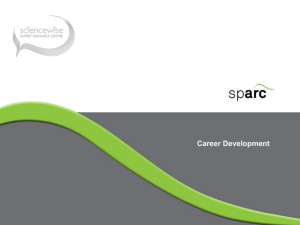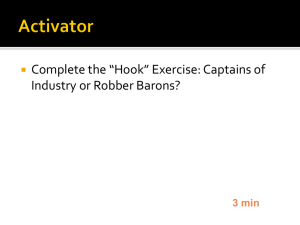Bullen_-_Workforce_Trends_in_Information_Technology
advertisement
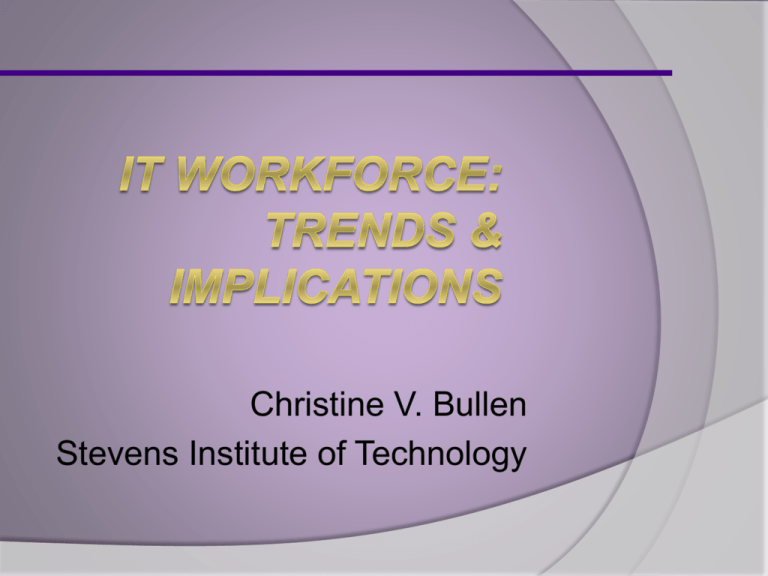
Christine V. Bullen Stevens Institute of Technology Collegial Collaborators Tom Abraham Cynthia Beath Keith Frampton Kevin P. Gallagher Tim Goles Kate M. Kaiser, Stephen Hawk Judith Simon Kean University University of Texas-Austin The Marlo Group Northern Kentucky University Texas A&M International Marquette University University of Wisconsin-Parkside University of Memphis Motivation for Studying the IT Workforce Consistent top concern of IT management Changing times ○ Low university IT enrollments ○ Pending baby boomer retirements ○ Migrating skills ○ Shift in function and location of IT providers © ITWF Team Phase 1 and Phase 2 Phase 1 - Clients Skills and capabilities critical in house vs. sourced 104 senior executives interviews– primarily SIM members Wide range of sizes and industries Found increased use of providers Phase 2 - Providers Capabilities critical in house to serve clients 153 senior executives online survey Wide range of sizes and global locations How do providers compare to clients? Mission Change for IT From Delivering technology-based solutions To Managing process of delivering solutions © ITWF Team Capability Categories – both phases TECHNICAL PROJECT MANAGEMENT BUSINESS DOMAIN SOURCING © ITWF Team Entry Level Skills ≠ Career Success Skills critical in house Project Planning Process Knowledge Company Knowledge BPR Systems Analysis Industry Knowledge Project Leadership Project Risk Management Systems Design Change Management Skills desired in mid-level hires Project Planning Project Leadership Project Risk Management Systems Analysis User Relationship Management Systems Design Negotiation Industry Knowledge Process Knowledge Project Integration Skills sourced from 3PPs Programming Systems Testing Desktop/Helpdesk Systems Design Systems Analysis Voice/DataTelecomm Database Design Continuity/Recovery Operations Server Hosting OS/ Architecture & Standards Skills desired in entry-level hires Programming Systems Analysis Systems Testing Systems Design Communication Voice/Data Telecomm Desktop/Helpdesk Architecture & Standards Database Design Implications for Curriculum and Hiring Marketplace – clients and providers Demanding new patterns of capabilities Competing for same talent pool T-shaped people Deep technical and broad client-facing skills (developers and specialists) Deep client-facing and broad technical skills (analysts and managers) Importance of client-facing skills increasing-especially high-wage areas Project management Communication Business domain © ITWF Team Gartner Report Favors IT Investment •Enterprises face challenging economic environment 2010 •Solutions through IT • Contribute to overall corporate results • Reduce enterprise and IT costs •CIOs need to be decisive and resourceful in building an effective future enterprise Gartner: Meeting the Challenge of the 2009 CIO Agenda The Global Sourcing Factor Sourcing activities slowed 2008 Leading providers posted losses Consolidations beginning Overall Outlook Positive Pipeline of work is good More smaller engagements Moving from “lift & shift” to partnerships for developing IP and industry process competence 60% of those outsourcing have aggressive plans to expand Global Services & NeoIT, 2009, TPI, Equaterra, Duke Ciber Issues for Interactive Discussion What are your concerns? How to manage cost cutting? Layoffs? Hiring? Sourcing? Are you increasing sourcing? On-shore vs. offshore How has talent supply been affected? More talent available due to layoffs? More talent available postponing retirement? Fewer H1B visas? Universities low enrollments? discontinuing or merging IT programs? Concerned about skills pipeline? The “Lost Generation” Contact Information Christine V. Bullen cbullen@stevens.edu IT Workforce Collaborative Many articles on SIM Web site under Communities tab White papers Phase 1: THE INFORMATION TECHNOLOGY WORKFORCE: TRENDS AND IMPLICATIONS 2005-2008 Phase 2: THE INFORMATION TECHNOLOGY WORKFORCE: IT PROVIDER TRENDS AND IMPLICATIONS 2006-2009



